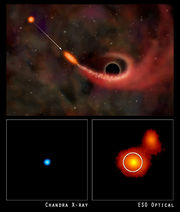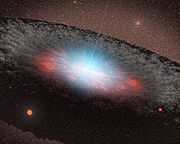Supermassive black hole

A supermassive black hole is the largest type of black hole in a galaxy, on the order of hundreds of thousands to billions of solar masses. Most, if not all galaxies, including the Milky Way,[2] are believed to contain supermassive black holes at their centers.[3][4]
Supermassive black holes have properties which distinguish them from lower-mass classifications:
- The average density of a supermassive black hole (defined as the mass of the black hole divided by the volume within its Schwarzschild radius) can be very low, and may actually be lower than the density of air. This is because the Schwarzschild radius is directly proportional to mass, while density is inversely proportional to the volume. Since the volume of a spherical object (such as the event horizon of a non-rotating black hole) is directly proportional to the cube of the radius, and mass merely increases linearly, the volume increases by a much greater factor than the mass as a black hole grows. Thus, average density decreases for increasingly larger radii of black holes (due to volume increasing much faster than mass).
- The tidal forces in the vicinity of the event horizon are significantly weaker. Since the central singularity is so far away from the horizon, a hypothetical astronaut traveling towards the black hole center would not experience significant tidal force until very deep into the black hole.
Contents |
Formation

There are many models for the formation of black holes of this size. The most obvious is by slow accretion of matter starting from a black hole of stellar size. Another model[5] of supermassive black hole formation involves a large gas cloud collapsing into a relativistic star of perhaps a hundred thousand solar masses or larger. The star would then become unstable to radial perturbations due to electron-positron pair production in its core, and may collapse directly into a black hole without a supernova explosion, which would eject most of its mass and prevent it from leaving a supermassive black hole as a remnant. Yet another model[6] involves a dense stellar cluster undergoing core-collapse as the negative heat capacity of the system drives the velocity dispersion in the core to relativistic speeds. Finally, primordial black holes may have been produced directly from external pressure in the first instants after the Big Bang.
The difficulty in forming a supermassive black hole resides in the need for enough matter to be in a small enough volume. This matter needs to have very little angular momentum in order for this to happen. Normally the process of accretion involves transporting a large initial endowment of angular momentum outwards, and this appears to be the limiting factor in black hole growth, and explains the formation of accretion disks.
Currently, there appears to be a gap in the observed mass distribution of black holes. There are stellar-mass black holes, generated from collapsing stars, which range up to perhaps 33 solar masses. The minimal supermassive black hole is in the range of a hundred thousand solar masses. Between these regimes there appears to be a dearth of intermediate-mass black holes. Such a gap would suggest qualitatively different formation processes. However, some models[7] suggest that ultraluminous X-ray sources (ULXs) may be black holes from this missing group.
Doppler measurements
Direct Doppler measures of water masers surrounding the nucleus of nearby galaxies have revealed a very fast keplerian motion, only possible with a high concentration of matter in the center. Currently, the only known objects that can pack enough matter in such a small space are black holes, or things that will evolve into black holes within astrophysically short timescales. For active galaxies farther away, the width of broad spectral lines can be used to probe the gas orbiting near the event horizon. The technique of reverberation mapping uses variability of these lines to measure the mass and perhaps the spin of the black hole that powers the active galaxy's "engine".
Such supermassive black holes in the center of many galaxies are thought to be the "engine" of active objects such as Seyfert galaxies and quasars.
Supermassive black hole hypothesis
Astronomers are confident that our own Milky Way galaxy has a supermassive black hole at its center, in a region called Sagittarius A*[8] because:
-
- The star S2 follows an elliptical orbit with a period of 15.2 years and a pericenter (closest distance) of 17 light hours from the center of the central object.[9]
- From the motion of star S2, we estimate the object's mass as 4.1 million solar masses.[10]
- We also know that the radius of the central object is significantly less than 17 light hours, because otherwise, S2 would either collide with it or be ripped apart by tidal forces. In fact, recent observations[11] indicate that the radius is no more than 6.25 light-hours, about the diameter of Uranus' orbit.
- The only known object which can pack 4.1 million solar masses into a volume that small is a black hole.
The Max Planck Institute for Extraterrestrial Physics and UCLA Galactic Center Group[12] have provided the strongest evidence to date that Sagittarius A* is the site of a supermassive black hole,[8] based on data from the ESO[13] and the Keck telescope.[14] Our galactic central black hole is calculated to have a mass of approximately 4.1 million solar masses,[15] or about 8.2 × 1036 kg.
Supermassive black holes outside the Milky Way
It is now widely accepted that the center of nearly every galaxy contains a supermassive black hole.[16][17] The close observational correlation between the mass of this hole and the velocity dispersion of the host galaxy's bulge, known as the M-sigma relation[18], strongly suggests a connection between the formation of the black hole and the galaxy itself.[16]
The explanation for this correlation remains an unsolved problem in astrophysics. It is believed that black holes and their host galaxies coevolved between 300-800 million years after the Big Bang, passing through a quasar phase and developing correlated characteristics, but models differ on the causality of whether black holes triggered galaxy formation or vice versa, and sequential formation cannot be excluded. The unknown nature of dark matter is a crucial variable in these models.[19][20]
At least one galaxy, Galaxy 0402+379, appears to have two supermassive black holes at its center, forming a binary system. If they collide, the event would create strong gravitational waves. Binary supermassive black holes are believed to be a common consequence of galactic mergers.[21] As of November 2008[update], another binary pair, in OJ 287, contains the most massive black hole known, with a mass estimated at 18 billion solar masses.[22]
Currently, there is no compelling evidence for massive black holes at the centers of globular clusters, or smaller stellar systems.
See also
- Active galactic nucleus
- Black hole
- Fuzzball (string theory)
- Galaxy
- Galactic center
- Hypercompact stellar system
- Neutron star
- Quasar
- M-sigma relation
- Sagittarius A*
- Spin-flip
References
- ↑ Chandra :: Photo Album :: RX J1242-11 :: 18 Feb 04
- ↑ Schödel, R.; et al. (2002). "A star in a 15.2-year orbit around the supermassive black hole at the centre of the Milky Way". Nature 419 (6908): 694–696. doi:10.1038/nature01121. PMID 12384690.
- ↑ Antonucci, R. (1993). "Unified Models for Active Galactic Nuclei and Quasars". Annual Reviews in Astronomy and Astrophysics 31 (1): 473–521. doi:10.1146/annurev.aa.31.090193.002353.
- ↑ Urry, C.; Paolo Padovani (1995). "Unified Schemes for Radio-Loud Active Galactic Nuclei". Publications of the Astronomical Society of the Pacific 107: 803–845. doi:10.1086/133630.
- ↑ Begelman, M. C.; et al. (Jun 2006). "Formation of supermassive black holes by direct collapse in pre-galactic haloes". Monthly Notices of the Royal Astronomical Society 370 (1): 289–298. doi:10.1111/j.1365-2966.2006.10467.x.
- ↑ Spitzer, L. (1987). Dynamical Evolution of Globular Clusters. Princeton University Press. ISBN 0691083096.
- ↑ Winter, L.M.; et al. (Oct 2006). "XMM-Newton Archival Study of the ULX Population in Nearby Galaxies". Astrophysical Journal 649: 730–752. doi:10.1086/506579.
- ↑ 8.0 8.1 Henderson, Mark (December 9, 2008). "Astronomers confirm black hole at the heart of the Milky Way". Times Online. http://www.timesonline.co.uk/tol/news/uk/science/article5316001.ece. Retrieved 2009-05-17.
- ↑ Schödel, R.; et. al. (17 October 2002). "A star in a 15.2-year orbit around the supermassive black hole at the centre of the Milky Way". Nature 419 (419): 694–696. doi:10.1038/nature01121. arXiv:astro-ph/0210426. http://www.nature.com/nature/journal/v419/n6908/abs/nature01121.html. Retrieved 2009-07-27.
- ↑ http://en.wikipedia.org/wiki/Sagittarius_A*#Supermassive_black_hole_hypothesis
- ↑ Ghez, A. M.; Salim, S.; Hornstein, S. D.; Tanner, A.; Lu, J. R.; Morris, M.; Becklin, E. E.; Duchêne, G. (May 2005). "Stellar Orbits around the Galactic Center Black Hole". The Astrophysical Journal 620 (2): 744–757. doi:10.1086/427175. arXiv:astro-ph/0306130v2. http://www.journals.uchicago.edu/doi/abs/10.1086/427175. Retrieved 2008-05-10.
- ↑ UCLA Galactic Center Group
- ↑ ESO - 2002
- ↑ http://www.keckobservatory.org/news/old_pages/andreaghez.html
- ↑ http://www.skyandtelescope.com/news/27621359.html
- ↑ 16.0 16.1 King, Andrew (2003-09-15). "Black Holes, Galaxy Formation, and the MBH-σ Relation". The Astrophysical Journal (The American Astronomical Society.): 596:L27–L29. http://www.iop.org/EJ/article/1538-4357/596/1/L27/17559.text.html.
- ↑ Richstone, D. et al. (January 13, 1997). "Massive Black Holes Dwell in Most Galaxies, According to Hubble Census". 189th Meeting of the American Astronomical Society. http://hubblesite.org/newscenter/archive/releases/1997/01/text/. Retrieved 2009-05-17.
- ↑ Merritt, D. (2001-01-15). "The MBH-σ Relation for Supermassive Black Holes". The Astrophysical Journal (The American Astronomical Society.): 547:140–145. http://adsabs.harvard.edu/abs/2001ApJ...547..140M.
- ↑ Robert Roy Britt (2003-07-29). "The New History of Black Holes: 'Co-evolution' Dramatically Alters Dark Reputation". http://www.space.com/scienceastronomy/blackhole_history_030128-1.html.
- ↑ "Astronomers crack cosmic chicken-or-egg dilemma". 2003-07-22. http://www.astronomy.com/asy/default.aspx?c=a&id=2165.
- ↑ D. Merritt and M. Milosavljevic (2005). "Massive Black Hole Binary Evolution." http://relativity.livingreviews.org/Articles/lrr-2005-8/
- ↑ Shiga, David (10 January 2008). "Biggest black hole in the cosmos discovered". NewScientist.com news service. http://space.newscientist.com/article/dn13166-biggest-black-hole-in-the-cosmos-discovered.html.
Further reading
- Fulvio Melia (2003). The Edge of Infinity. Supermassive Black Holes in the Universe. Cambridge University Press. ISBN 978-0-521-81405-8.
- Laura Ferrarese and David Merritt (2002). "Supermassive Black Holes". Physics World 15 (1): 41–46. http://adsabs.harvard.edu/abs/2002astro.ph..6222F.
- Fulvio Melia (2007). The Galactic Supermassive Black Hole. Princeton University Press. ISBN 978-0-691-13129-0.
- Julian Krolik (1999). Active Galactic Nuclei. Princeton University Press. ISBN 0-691-01151-6.
External links
- Black Holes: Gravity's Relentless Pull Award-winning interactive multimedia Web site about the physics and astronomy of black holes from the Space Telescope Science Institute
- Images of supermassive black holes
- NASA images of supermassive black holes
- The black hole at the heart of the Milky Way
- ESO video clip of orbiting star (533 KB MPEG Video)
- Star Orbiting Massive Milky Way Centre Approaches to within 17 Light-Hours ESO, October 21, 2002
- Images, Animations, and New Results from the UCLA Galactic Center Group
- Washington Post article on Supermassive black holes
- A simulation of the stars orbiting the Milky Way's central massive black hole
|
||||||||||||||||||||||||||||
